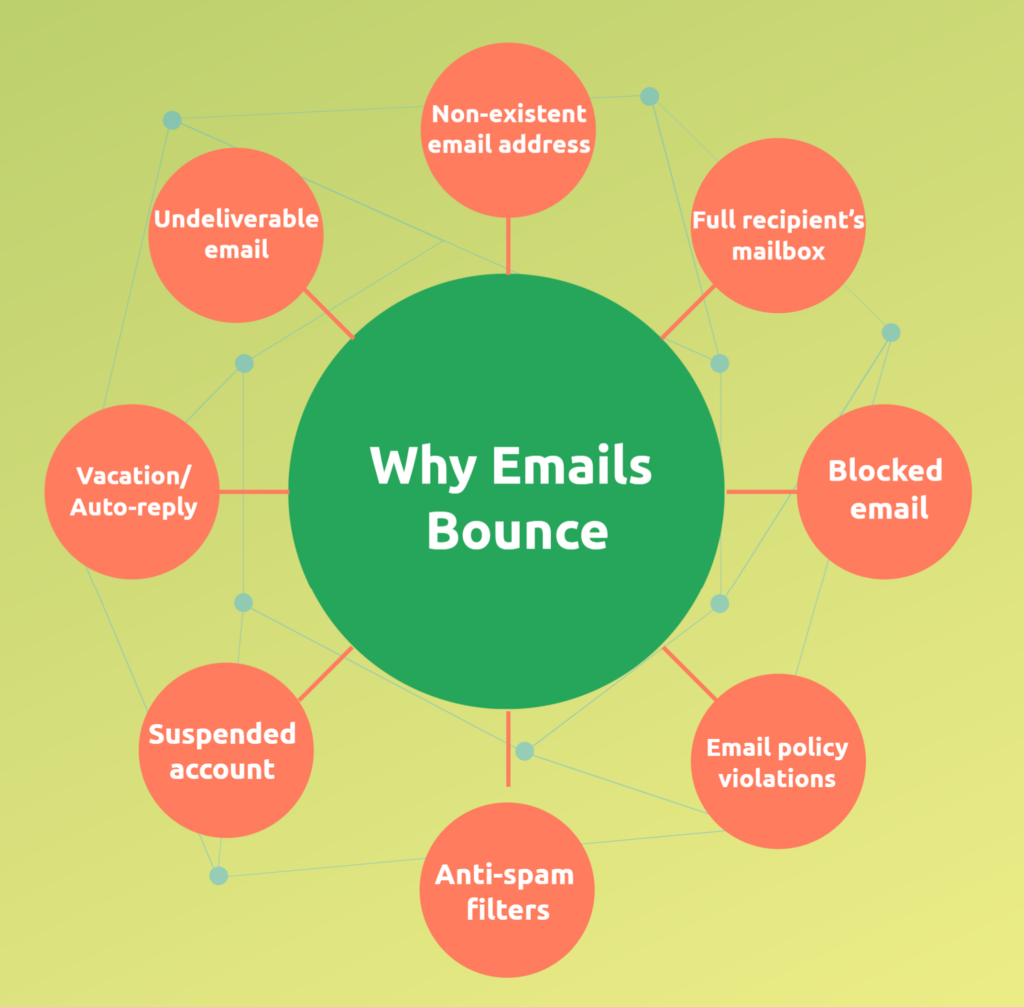- Home
- Email Tips and Tricks
- 7 Reasons Why Emails Bounce an ...

An email bounce occurs when a sent message cannot be delivered to the recipient’s mailbox and is returned to the sender. If you wonder, “Why do emails bounce?” the simple answer is: for multiple reasons. Invalid email addresses, full inboxes, or server problems—each can cause an email to bounce. Nonetheless, if you want to dive deeper into a topic and also learn how to prevent or minimize bounces, read further.
By understanding the spectrum of causes and the impact they have on email communication, you can improve your email management practices and ensure your messages reach their intended destinations. Stay tuned as we explore these reasons in detail and provide actionable solutions to help mitigate the challenges of bounced emails.
What Is an Email Bounce?
An email bounce occurs when an email sent to a recipient fails to be delivered and is returned to the sender. This issue can significantly impact email campaigns, as it directly affects deliverability rates and, by extension, the overall success of marketing efforts.
If you want to make sure that your email list remains healthy and communication-effective, it is crucial to understand what a bounced email is. There are two primary types of bounces: a hard bounce and a soft bounce. A hard bounce indicates a permanent reason an email cannot be delivered, such as an invalid email address. A soft bounce, on the other hand, is typically a temporary issue, like a full inbox or a server being down. This type of bounce is usually resolved on its own and requires minimal or no input from the sender’s side.
Understanding what it means when an email bounces and finding your particular reasons is crucial. Like this, you can either eliminate an underlying issue of hard bounces or make the soft ones less frequent.
How Do You Know if an Email Is Bounced?
Knowing if your emails have bounced is crucial for keeping your campaign effectiveness at the due level. If your email bounced, most email clients like Outlook, Gmail, or Apple Mail will automatically notify you about a failed attempt. These notifications often come in the form of a return or bounce message from the recipient’s mail server, detailing the reason for the bounce.
If you have some technical knowledge and can access your email server, server logs can provide detailed information about email delivery status, including which emails were bounced and why. Finally, there’s manual follow-up. In cases where email communication is critical (e.g., job applications, important business communications), following up through alternative channels such as phone or messaging apps can verify whether the initial email was received.
Nonetheless, this method, while acceptable for individual emails, might not be the best choice for checking bounce rates for email campaigns. For this purpose, it might be beneficial to use one of the email marketing platforms that provide comprehensive analytics and reporting tools. Like this, you can automate bounced emails tracking, which is both efficient and time-saving.
These platforms categorize bounces into hard and soft ones, which provides you with a good overview of what a bounced email means specifically for your campaign. Email marketers can use this data to clean their lists by removing invalid addresses (hard bounces) and investigating the causes behind soft bounces, like adjusting the size of the email content or the sending times to avoid server downtime periods.
Email analytics also often include detailed reports that highlight the bounce rate, which is the percentage of emails that failed to deliver out of the total sent. Monitoring these metrics and seeing how they fluctuate provides you with a clear picture of your emails’ deliverability over time.
Common Reasons Why Emails Bounce

1. Non-existent email address. In most cases, what causes an email to bounce is a non-existent email address. This type of email bounce occurs because the email address does not exist, was mistyped, or was deliberately falsified. For instance, if someone signs up for a newsletter with user@examplle.com (note the misspelling), emails sent to this address will result in a hard bounce. Understanding the bounced email meaning in this context helps in recognizing the need for accurate data collection and verification processes. The easiest way to handle that issue is to use an email checker.
2. Undeliverable email. An email may become undeliverable for several reasons, including server problems or domain issues. When you wonder why my email is undeliverable, consider factors like the recipient’s server being temporarily unavailable or DNS failures. Even when the email is undeliverable but the address is correct, these technical issues can prevent successful delivery, leading to a soft bounce, which might resolve itself later.
3. Full recipient’s mailbox. This bounce occurs when the recipient’s inbox is full and can no longer accept new emails. In the context of email bouncing, a full mailbox is a typical reason why this type of bouncing occurs. This indicates temporary deliverability issues that might be resolved once the recipient clears their mailbox.
4. Vacation/Auto-reply. Although not a traditional bounce, emails marked with a vacation or auto-reply message can sometimes be confused with bounces. These messages do not indicate a failure in delivery but rather inform the sender that the recipient is temporarily unavailable. It is crucial to understand that, unlike a typical email bounce, these notifications do not impact the sender’s reputation in a negative way.
5. Blocked email. One of the less pleasant reasons for a bounced email is email blocking, where emails are blocked by the recipient’s email server due to reasons like suspected spam or content filtering settings. This type of rejection is considered a hard bounce if the server decides to permanently block incoming emails from the sender, emphasizing the importance of maintaining a good sender reputation.
6. Suspended account. If an email account has been deactivated or suspended, perhaps due to inactivity or breach of terms of service, any attempt to send an email to it will result in a hard bounce. This scenario is essential to consider when investigating, “Why would an email be undeliverable?” as it requires removing such addresses from the mailing list permanently.
7. Other reasons. There are other, less common factors that might lead to an email being returned. These include, but are not limited to, email policy violations (like sending too large attachments), anti-spam filters catching certain phrases, or technical issues on the sender’s side. Each of these issues underscores the broader question, “Why do emails bounce?” and the various steps senders must take to minimize such occurrences.
How Do You Handle a Bounced Email?
When you encounter an email bounce, here are some steps you can take to minimize its impact on your campaign’s efficiency:
- Identify the type of bounce: Determine whether the bounce is hard or soft. This differentiation is essential, as it defines your next steps. Hard bounces typically result from invalid addresses or suspended accounts and require immediate removal from your list. Soft bounces might resolve themselves and could be retried.
- Try resending: For soft bounces, consider resending the email after a brief period. Sometimes, issues like full mailboxes or server downtimes resolve themselves quickly.
- Update your email lists: Regularly clean your email list by removing addresses that consistently generate hard bounces. Keeping your list updated helps in maintaining a good sender reputation.
- Revise your email practices: Evaluate your email collection and verification practices to prevent future issues. Implementing double opt-in processes where recipients confirm their email addresses can dramatically reduce the rate of hard bounces.
- Monitor bounce rates: Keep an eye on your bounce rates. High rates might indicate bigger issues, such as problems with your email content, sending practices, or list hygiene.
Should I Delete Bounced Emails?
Yes, you should delete bounced emails, but with some considerations:
- Hard bounces: Always delete email addresses that result in hard bounces. These addresses are either invalid or no longer active. Keeping them can harm your sender’s reputation and deliverability rates.
- Soft bounces: Handle these more cautiously. If an email address continuously soft bounces (e.g., in three consecutive campaigns), it should be treated as a hard bounce and removed from your list.
To Sum Up
In this article, we explored two different types of email bounces—soft and hard ones—as well as how to prevent them from happening and ways to minimize their impact on your campaign. While soft bounces are less critical than hard ones, it is crucial to understand both types since high bounce rates can severely impact your email campaigns’ effectiveness and hurt your sender’s reputation. Eventually, email bouncing can even lead to blacklisting by email service providers (ESPs), making it harder to get emails delivered in the future.
While not the only one, the email bounce rate is one of the indirect indicators of your campaign success. Monitoring bounce rates, especially with special tools like marketing platforms, allows for detailed insights on bounce rates and other success-critical metrics. If done regularly, this practice can help identify and rectify issues early on and ensure that your email campaigns maintain high ongoing deliverability and engagement rates.



